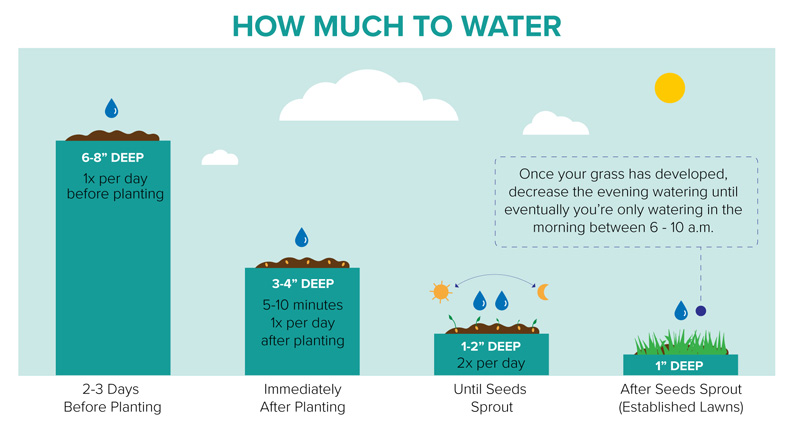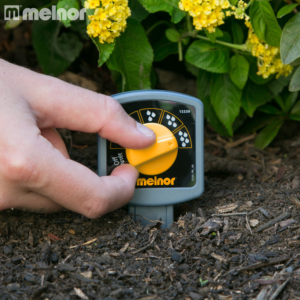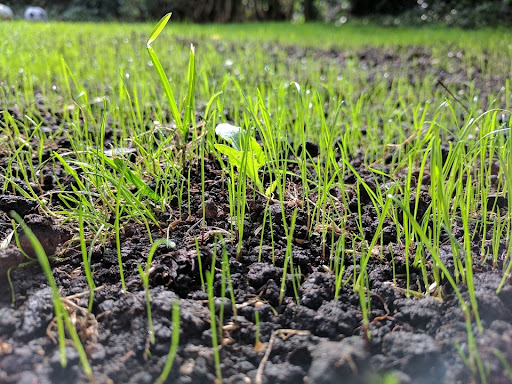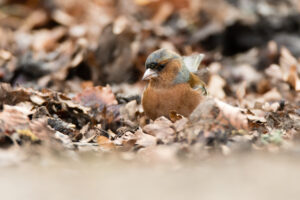
You just got home from a long day of work, responsibilities, and errands. You’re excited to eat the chicken parm you’ve been thinking about for six and a half hours.
However, before you can step inside to soak up the pleasant smell and devour your dinner, you notice for the 17th time that your grass needs help. Dead or yellowing grass isn’t pleasing to see after a long day. Tossing the football and playing tag on drying grass is no fun if you have kids.
Many factors play into the health of your lawn, such as climate, irrigation, seasonality, and more. Although there’s no secret formula to growing grass, there are proven methods to help your chances! Learn how to keep your grass green all summer or start new grass by seed.
Grass Watering Guide
If your grass is yellow, browning, or dead, it is a clear sign to water your lawn. Sometimes it’s not that obvious, though. Observing small, more specific changes is needed to know if your grass is under-watered. Here are three (3) ways to know when water your grass:
- Color Change. It’s time to water your grass when you notice a color change — even when the change is slight. Grayish, dull-green tones typically appear first when your lawn is dehydrated.
- Curly Blades. Look at your lawn and observe the grass blades. If you notice them curled or withering, your grass is not hydrated, and it’s time to water.
- Step Test. The last method involves walking on your lawn. If the footprints you’ve left behind don’t bounce back to form, the grass blades lack the moisture they need to bounce back.
When Do I Water My Lawn?
Note: It’s worth mentioning that watering your grass isn’t required. Grass can withstand a lot of abuse and long periods of drought. Lawns that have been well-established and well-cared-for can quickly bounce back from weeks of yellow shading (dormant grass). The static grass will revive once the rain, or irrigation, returns.
The best time to water your lawn is first thing in the morning — before 10:00 AM. If you live in an area with more sun exposure, consider watering earlier in the morning to catch cooler, less breezy conditions. Watering in the morning allows the water to be absorbed by the grassroots before evaporation occurs. If you must water your grass in the afternoon, we recommend watering between 4:00 – 6:00 PM. Watering during peak sun hours increases evaporation which reduces growth.
If you are busy like us, you need a little help. Melnor’s smart water timers are the perfect tool to water your lawn automatically. So you can set and forget it.
Discover climate trends in your area with our Plant Hardiness Zone Calculator (data available only for the U.S. and Puerto Rico only). Download the calculator here!
Why Not Just Wait Until Dusk? The later in the day you water, the more likely disease will spread in among your grass. This is because many fungal and bacterial plant diseases rely on moist foliage to reproduce.
How Much Water Do I Use?
Common practice is to water established lawns until the top 1-1.5 inches of soil (where most grass roots develop) are saturated. You may reach this depth from rain or, if you live in arid regions, hose-end watering tools. We recommend this amount of water for a single watering. Or you can split between two waterings during the week (not recommended). Ensure not to over water and that each section of your grass is hit. Use the graphic below to learn about watering requirements at different stages of the planting process.

The XT line of Oscillating Sprinklers by Melnor® come equipped with features like a flow control, built-in timer, and 360° degree watering for full coverage watering.
Why are split waterings not recommended? Split waterings increase the likelihood that your grass will develop diseases from continuous moisture. Letting your grass dry and soak up the water in the soil will promote the most growth. Tools are available that will assist you in maintaining proper moisture levels.

For example, the Melnor® Soil Moisture Sensor monitors how wet the soil is to automatically skip watering when it rains or the soil is too damp.
This can be helpful if you live in an area like California that fines individuals $500 for watering lawns within 48 hours after a rainstorm. With the Soil Moisture Sensor, you won’t to have to worry about over-watering your lawn.
Have I Watered Enough?
Once you have watered your grass, you might be curious if that’s enough. Here are four (4) easy ways to check:
- Measure with tubs. This method is the most straightforward. Gather and place empty tubs (or whatever you can find) around your lawn in different spots. Measure how long it takes for those tubs to accumulate 1 to 1.5 inches of water. If you are using sprinklers to water your lawn, make sure to use the average time it takes to fill all the tubs because the coverage patterns may vary around the grass.
- Check the soil. Using a stick, assess how deep the absorption level has moved during your initial watering to see how long it will take to soak the soil. Once the wetness has reached a depth of at least six inches, make a note of the time; this is how long you need to water your grass in the future. If you forget to water your grass one day and want to know if it’s okay, try inserting that stick into your soil. If you’re not able to easily insert your stick six inches deep, you need to water your lawn.
- Check your flow rate. This method requires math but will get you the same result. First, multiply the square footage of the section of grass you plan to grow by 0.93 (1.5 inches of water per sq. ft.). This will give you the total water required (in gallons) to adequately water your grass. Next, take this number and divide it by your Melnor® sprinkler’s flow rate (GPM). This will tell you the number of minutes required to reach 1.5 inches of water per square foot. Formula:
Step 1

Step 2

Don’t know the square footage of your section? Use our lawn size calculator.
- Use Water Timers. The last way to check if you watered your lawn enough involves water timers. Choose a water timer, such as the Melnor® Flowmeter Water Timer, that can measure and dispense water in hundreds of gallons.
- Using our lawn size calculator, to help determine the square footage of the section you are trying to water and multiply by 0.93 (1.5 inches of water per sq. ft). This will give you the total water required in gallons. Once you have that number, simply turn the water timer’s knob to the amount of water you’ll need to dispense.
Note: The Melnor Flowmeter water timer will adjust for varying home water pressures and will apply the exact water needed.
Different Types of Grasses
Understanding different types of grasses and where they’re primarily found are vital because they vary in characteristics and watering requirements. Warm-season grasses, on average, require more water than cool-season grasses. This is due to the impact of summer weather conditions.
In general, situations like high heat, drought, low humidity, and high winds found in southern states cause the moisture in the soil to evaporate more rapidly. Thus, to keep your grass thriving in these locations, you need to adjust your watering schedule.
Grass varieties include:
- Warm-season grasses. These include but are not limited to St. Augustine, Bahia, and Bermuda grasses. These grasses are found in southern states closer to Texas, Mississippi, and the Gulf of Mexico.
- Cool-season grasses. Rye, Kentucky Bluegrass, and Tall Fescue are the most popular cool-season grasses. They are found closer to northern states such as Michigan and Ohio.
- Use our Plant Hardiness Zone Calculator to determine climate trends in your region.
What If I Am Starting From Seed?

Growing a patch of grass from seed requires a different strategy. During the germination phase, when seeds begin sprouting and developing roots, the soil must remain moist. Grass seeds need these wet environments to start the process of growth. Otherwise, grass seeds that dry out will eventually die.
Grass Seed Preparation. Water the entire area around 6-8 inches deep each day for a few days before sowing your fresh grass seed. After planting the seed, moisten the top two inches of soil for 5-10 minutes. The sown area must remain wet so that the grass seed does not dry out.
How Often Do I Water Grass Seed? Watering new grass seed is best in the mornings before 10:00 AM. If meeting this requirement is too challenging for your schedule, you may water in the evening when it’s not hot. This lessens evaporation and allows the soil to absorb more water.
Water timers may also help solve the problem. Melnor’s complete line of Smart Watering Timers lets you schedule and make adjustments ahead of time, so there’s no stress over sticking to your watering routine. They are available in one, two, or four-zone units so that you can complete multiple watering tasks at once.
How Much Do I Water Grass Seed? The amount of water your new grass requires is limited by sprinkler water dispersion, soil, and the weather. Ten minutes in the morning and ten minutes in the evening should be plenty to keep the top two inches of soil moist. Water the seedlings longer and less frequently as they grow to encourage the roots to penetrate deeper into the soil.
To determine your sprinkler’s water flow rate, refer to the section titled, “How to Tell If I’ve Watered Enough.”
How Long Does Grass Seed Take to Grow? The time it takes for grass seeds to germinate might range from 5 to 30 days. Because the roots will not sprout simultaneously, the soil must remain wet throughout this period until all the seeds have germinated.
Things to Avoid When Growing Grass
Evaporation. When growing new grass, especially from seed, do your best to eliminate evaporation. You can cover your new grass seed with straw or mulch.
Over-watering. Most well-prepared, new lawns are tilled to loosen the soil. Thus, this loose soil is prone to retaining lots of water. Seat soil becomes spongy and will result in compaction when walked on. In addition, higher moisture levels after seeds germinate can cause disease. Consider using Soil Moisture Sensors to stay on top of your soil’s moisture levels.
Under-watering. A lack of irrigation will cause your fresh seedlings to wither or grass blades to curl. As a result, you should create a lawn watering routine if you want the best chances of success.
Conclusion
The secret to growing a beautiful lawn is a consistent watering routine. Melnor makes it efficient and straightforward using our watering tools. It is essential to water your lawn deeply and infrequently to create a lawn that will endure even in summer’s hottest, driest phases.
If you’re planning to revive your yellow grass or start from scratch with a new grass seed, we hope this guide will assist you along the way.
Are you looking to purchase any of our products mentioned in the blog? You can buy them from these retailers near you.




